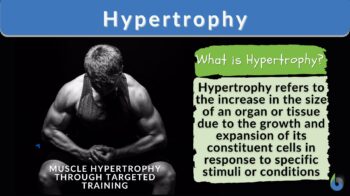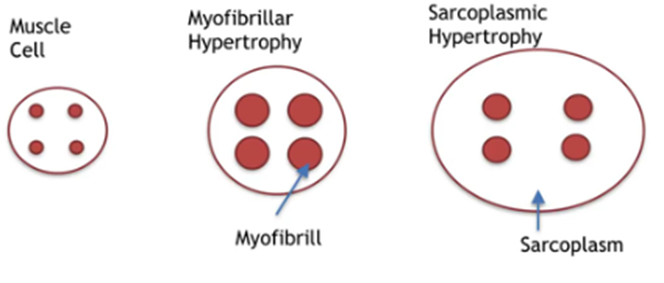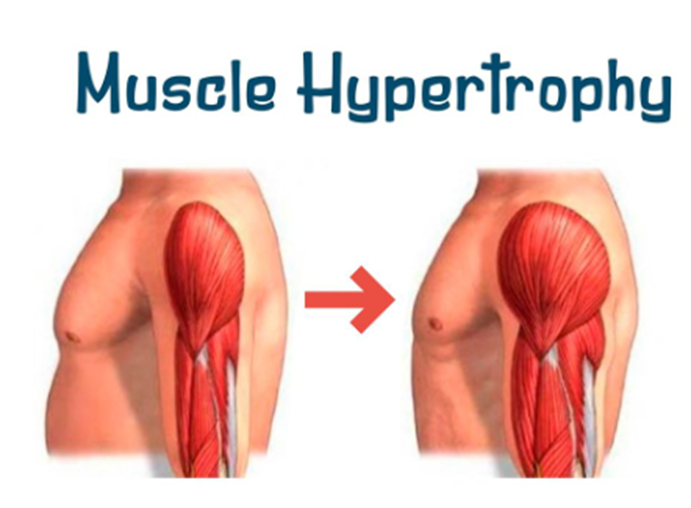
Hypertrophy
n., plural: hypertrophies
[haɪˈpɜːtɹəfi]
Definition: Increase in muscle size from the increase in size of individual muscle cell
Table of Contents
Hypertrophy Definition
Hypertrophy refers to the enlargement or increase in the size of an organ or tissue due to the growth and expansion of its constituent cells in response to specific stimuli or conditions. It is a natural physiological process that occurs in various contexts, such as muscle growth, cardiac adaptation, and organ development. Hypertrophy can also occur in tissues or organs in response to factors like increased workload, hormonal influences, or pathological conditions.
Types of hypertrophy
There are primarily two types of muscular hypertrophy (Roberts et al., 2020) :
- Myofibrillar Hypertrophy: This type of hypertrophy is characterized by an increase in the size and number of myofibrils within muscle fibers. Myofibrils are the contractile components of muscle cells that contribute to muscular strength. Myofibrillar hypertrophy is associated with heavy weight lifting or resistance training with high loads and low repetitions. It leads to an increase in muscle strength and is often pursued by athletes and powerlifters. Understanding the principles of hypertrophy and their application to resistance training allows individuals to strategically manipulate training variables such as volume, intensity, and exercise selection to optimize muscle growth and strength gains.
- Sarcoplasmic Hypertrophy: Sarcoplasmic hypertrophy involves an increase in the amount of sarcoplasm, the non-contractile fluid, and energy stored within muscle fibers. This type of hypertrophy is associated with high-volume training, typically with moderate weights and higher repetitions. Sarcoplasmic hypertrophy results in an increase in muscle size and volume but may not significantly improve muscle strength. It is often sought after by bodybuilders who aim to achieve a more aesthetically pleasing appearance.

Watch this vid about hypertrophy:
Biology definition:
Hypertrophy refers to the increase in size and strength of muscles through targeted exercise, specifically resistance training. It involves the thickening of muscle fibers and the accumulation of contractile proteins, resulting in improved muscular development.
Etymology: from Ancient Greek ὑπέρ (hupér), meaning “over or excessive”) and “τροφή” (trophḗ), meaning “nourishment”.
Compare: atrophy
What Causes Hypertrophy?
Mechanical tension occurs when muscles are subjected to resistance or load during exercises. This tension leads to microscopic damage in the muscle fibers, triggering a repair and growth response.
Metabolic stress, on the other hand, is the result of metabolic byproducts accumulating in the muscles during intense exercise. These byproducts, such as lactate and hydrogen ions, create an environment of metabolic stress within the muscle cells. This stress stimulates the release of anabolic hormones and increases muscle protein synthesis, contributing to hypertrophy.
When combined muscle hypertrophy occurs due to mechanical tension and metabolic stress
Hypertrophy training
- Lifting weights and Resistance exercises: Strength training can help people build muscle, both from myofibrillar and sarcoplasmic hypertrophy. This involves training against resistance that gradually increases over time. Regular resistance training exercises can help improve muscle tone by increasing muscle mass and reducing body fat, resulting in a more defined and sculpted appearance.
- Indulging in an exercise program with proper form and technique is crucial for targeting the intended muscle groups effectively. It reduces the risk of injury and ensures optimal muscle stimulation for hypertrophy.
- Supplements and sports medications are sold in stores and online as powders or pills for building endurance for hypertrophy training. One supplement that’s popular with athletes is called creatine monohydrate. It helps muscles release energy. Creatine supplements may help athletes gain small, short-term bursts of power but it comes with other side effects.
Hormonal factors
- Testosterone and growth hormone: Hormones such as testosterone and growth hormone play significant roles in muscle hypertrophy. Testosterone promotes protein synthesis, muscle repair, and the development of lean muscle mass. Similarly, growth hormone is involved in stimulating cell growth and regeneration, including muscle tissue.
- Anabolic steroids: Anabolic steroids are synthetic variations of testosterone that can enhance muscle gain beyond the body’s natural capabilities. They increase protein synthesis, reduce muscle breakdown, and improve recovery, leading to accelerated muscle hypertrophy. However, their use is illegal without a prescription and carries significant health risks.
Nutritional considerations
- Caloric surplus and protein intake: Consuming more calories than you expend, provides the necessary energy for building muscle. Additionally, adequate protein intake is crucial for muscle hypertrophy as proteins are the building blocks of muscle tissue. Consuming 1.6-2.2 grams of protein per kilogram of body weight per day is often recommended for individuals aiming to build muscle mass.
Sports medicine combines the principles of caloric surplus and protein intake with personalized guidance to optimize muscle growth and enhance athletic performance, ensuring athletes achieve their muscle-building goals effectively and safely. Sports medicine professionals provide comprehensive support, considering factors such as individual needs, nutrient timing, and overall diet composition. - Role of macronutrients and micronutrients: Alongside protein, carbohydrates, and fats are essential macronutrients that provide energy for training and muscle repair. Adequate intake of carbohydrates replenishes glycogen stores, supporting exercise performance. Healthy fats contribute to hormone production and assist in absorbing fat-soluble vitamins. Furthermore, consuming a balanced diet rich in vitamins, minerals, and antioxidants ensures optimal cellular function and supports muscle growth.
- Caloric surplus and protein intake: Consuming more calories than you expend, provides the necessary energy for building muscle. Additionally, adequate protein intake is crucial for muscle hypertrophy as proteins are the building blocks of muscle tissue. Consuming 1.6-2.2 grams of protein per kilogram of body weight per day is often recommended for individuals aiming to build muscle mass.
Metabolic stress
- Metabolic stress also plays a crucial role in muscular hypertrophy, as it triggers signaling pathways and physiological changes within the muscle during intense resistance training. This stress leads to the accumulation of metabolic by-products, increased blood flow, and cellular swelling, which stimulate muscle protein synthesis and growth.
What Is An Example Of Hypertrophy?
An example of hypertrophy can be observed in the quadriceps muscles of an individual who regularly performs resistance training exercises such as squats and leg presses. Let’s learn more about muscular hypertrophy:
Muscular hypertrophy
Muscular hypertrophy, also known as muscle growth, is a fascinating process that allows the human body to increase muscle mass and size through various physiological adaptations. It involves the enlargement of individual muscle fibers as a result of repetitive and intense exercise or resistance training (exercise-induced muscle growth). This increase in size is primarily due to an expansion of the contractile proteins within the muscle fibers, leading to greater muscle mass, strength, and improved functional capacity (Phillips, 2014).
By promoting muscle growth, hypertrophy enhances athletic performance, enabling athletes to generate more force, power, and endurance. For fitness enthusiasts, muscle hypertrophy contributes to an aesthetically pleasing physique, boosting confidence, good mental health, and self-esteem.
Furthermore, it enhances metabolic rate, leading to a more efficient calorie burn, weight management, and improved body composition. By controlling training variables and proper nutrition, muscle hypertrophy becomes a cornerstone for athletes and fitness enthusiasts alike, helping them reach their performance and physique goals.

Mechanism of Muscle Hypertrophy
Muscle tissue in the human body is primarily composed of skeletal muscle, which is responsible for voluntary movements. Skeletal muscles are made up of individual muscle fibers, which are long, cylindrical cells capable of generating force and enabling muscle contractions. The size and number of muscle fibers play a crucial role in determining muscle mass and strength (Schiaffino et al., 2021).
The process of skeletal muscle hypertrophy is driven by two primary mechanisms:
- Mechanical Tension: When muscles are subjected to tension or load during resistance training, it creates micro-tears in muscle fibers. In response to this muscular damage, the body initiates a repair and adaptation process, leading to the synthesis of new proteins and the growth of muscle fibers. Repeatedly challenging the muscles in this way causes them to adapt by growing in size and strength.
- Muscle Protein Synthesis: Muscle protein synthesis is the process by which the body builds new proteins within muscle fibers. Resistance training, especially high-intensity exercises, stimulates muscle protein synthesis, leading to an increase in muscle mass and strength.
Stimulating Muscle Hypertrophy through Resistance Training
Resistance training, also known as strength training, is a key component in maximizing muscle hypertrophy. By challenging the muscles with external resistance, individuals can induce muscle growth and enhance muscle size and strength. Here are some important factors to consider when designing a hypertrophy-focused resistance training program (Schoenfeld, 2010):
- Training Volume: Training volume refers to the total amount of work performed in a training session, typically calculated by multiplying the number of sets, repetitions, and weights lifted. Higher training volumes have been shown to elicit more significant muscle hypertrophy.
- Training Intensity: Training intensity refers to the percentage of an individual’s one-repetition maximum (1RM) that they lift during an exercise. Moderate to high-intensity training is generally recommended to stimulate muscle hypertrophy effectively.
- Training Frequency: The frequency at which individuals perform resistance training exercises can significantly impact muscle hypertrophy. For most individuals, training each muscle group 2-3 times per week is optimal for maximizing muscle growth.

Advanced Resistance Training Techniques for Hypertrophy
Progressive Overload: Progressive overload is a fundamental principle in resistance training programs. It involves gradually increasing the demands placed on the muscles over time, either by increasing the weight lifted, the number of repetitions performed, or the training volume. Progressive overload ensures that the muscles continue to adapt and grow.
- Eccentric Training: Eccentric training focuses on the eccentric phase of an exercise, which involves the lengthening of the muscle under tension. This technique has been shown to produce significant metabolic stress and muscle damage, promoting muscle hypertrophy.
- Blood Flow Restriction Training: Blood flow restriction training involves partially occluding the blood flow to working muscles using specialized cuffs or wraps. This technique has gained popularity due to its ability to create metabolic stress and enhance muscle growth, even with lighter loads.
- Supersets and Drop Sets: Supersets involve performing two exercises back-to-back without rest, targeting the same muscle group. Drop sets, on the other hand, involve performing a set to failure and then immediately reducing the weight and continuing the exercise. These techniques increase training intensity and stimulate muscle hypertrophy.
Challenging Hypertrophy Exercises
- Compound Movements: Compound exercises involve multiple muscle groups and joints, making them highly effective for stimulating muscle hypertrophy. Examples include squats, deadlifts, bench presses, and overhead presses. These exercises allow for heavier loads and engage a larger muscle mass, leading to significant muscle growth.
- Isolation Exercises: Isolation exercises are ones that target specific muscle groups and allow for greater focus on muscle contraction. Examples include bicep curls, tricep extensions, and leg extensions. While not as effective for overall muscle growth as compound movements, isolation exercises can be valuable for targeting specific muscles and achieving balanced muscle development.
In order to maximize hypertrophy, people focus on incorporating progressive overload, proper nutrition, and adequate recovery into their resistance training programs.
Did you know…?
Did you know that resistance training and hypertrophy exercises not only increase muscle size and strength but also have a positive impact on mental health? Regular exercise can help reduce stress, boost mood, and improve overall well-being.
Take the Hypertrophy – Biology Quiz!
References
- Phillips, S. M. (2014). A brief review of critical processes in exercise-induced muscular hypertrophy. Sports Medicine, 44, 71-77.
- Roberts, M. D., Haun, C. T., Vann, C. G., Osburn, S. C., & Young, K. C. (2020). Sarcoplasmic hypertrophy in skeletal muscle: a scientific “unicorn” or resistance training adaptation?. Frontiers in Physiology, 11, 816.
- Schiaffino, S., Reggiani, C., Akimoto, T., & Blaauw, B. (2021). Molecular mechanisms of skeletal muscle hypertrophy. Journal of neuromuscular diseases, 8(2), 169-183.
- Schoenfeld, B. J. (2010). The mechanisms of muscle hypertrophy and their application to resistance training. The Journal of Strength & Conditioning Research, 24(10), 2857-2872.
©BiologyOnline.com. Content provided and moderated by Biology Online Editors.



